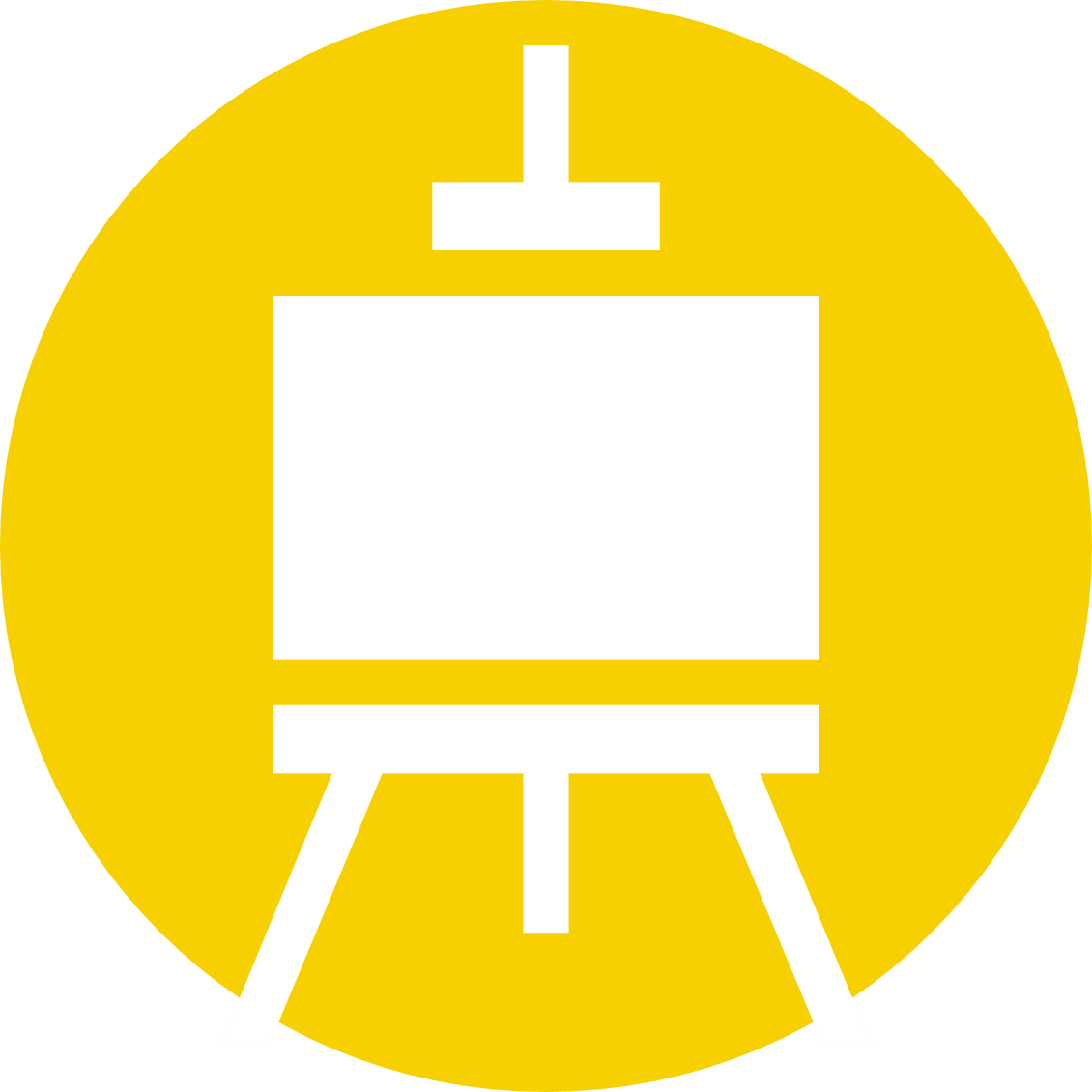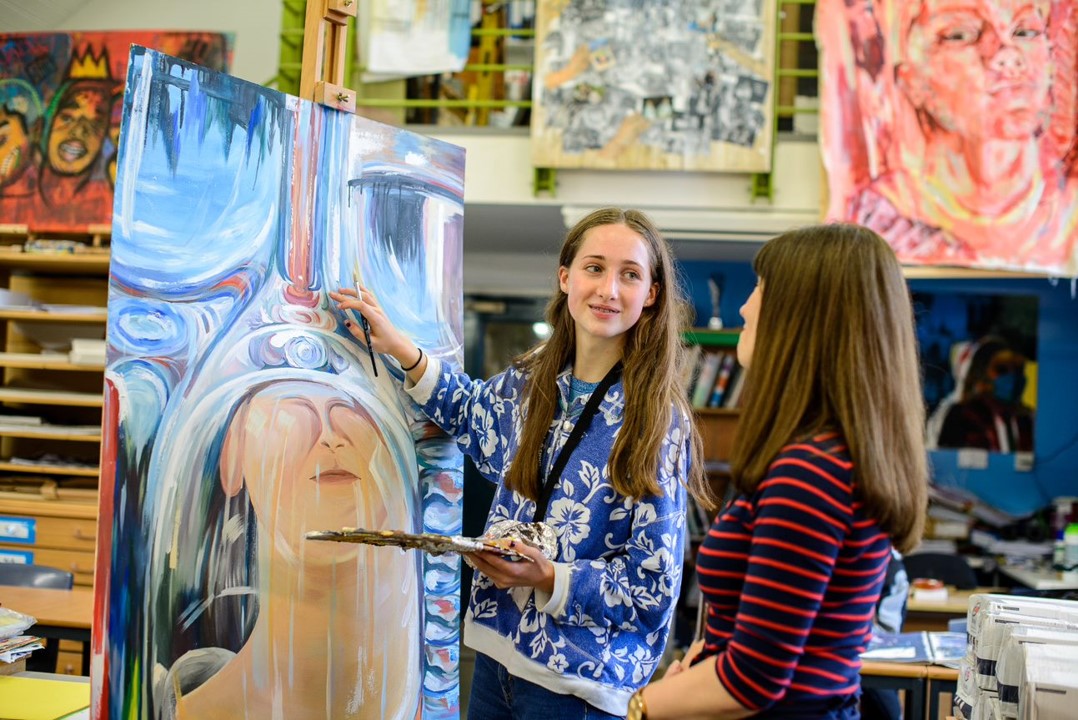Art
 Why study Fine Art?
Why study Fine Art?
Our Fine Art A-Level course offers students many opportunities to get involved in their own area of interest. A good proportion of our students go on Art and Design related courses post – 18 including Foundation, as well as direct entry onto a degree courses such as Fine Arts, Textile Design, Graphics and Advertising, Photography, 3D, Architecture, and illustrations.
In the Art Department at Notre Dame High School we feel that our students should have ownership of their work, an opportunity to create a visual language which says something about the way they understand the world. We believe that the diversity of students we teach should be reflected in their artwork.

Why our students like this course
‘The teachers’ knowledgeable help and advice have enabled me to develop my personal style…’
'Studying Art is an incredibly rich, interesting, rewarding and exciting A-Level. The teachers’ knowledgeable help and advice have enabled me to develop my personal style, allowing me to decide where I want to take my unconventional sculpture work. They have also guided me through the complex process of applying to arts universities and I plan to go onto study a degree in Fine Arts after completing an art based foundation year.'
Entry Requirements
A GCSE in this in this subject is desirable but not essential. If you don’t have this but have a talent in Art please discuss this with Mrs McShane, Head of Department.
Exam Board
EDEXCEL – Fine Arts (9FA0)
GCSE and A Level Virtual Gallery
Go on a virtual tour of our students' artwork.
Course Structure
| Y12 Half Term | |
|---|---|
| Autumn 1 |
‘Layers, Surfaces and Levels’ Contextual studies (Artists copies and analysis) |
| Autumn 2 |
Exploring ideas and media Selecting resources and refining Intermediate Outcome |
| Spring 1 |
Developing ideas Refining |
| Spring 2 |
Developed Outcome |
| Summer 1 |
Refining Ideas and media Final Outcome |
| Summer 2 |
‘Layers, Surfaces, Levels and Connections’ Begin Personal Study Essay (Begin Yr 13 work) |
| Y13 Half Term | Unit 1 | Unit 2 |
|---|---|---|
| Autumn 1 |
‘Layers, Surfaces, Levels and Connections’ Contextual studies (Artists copies and analysis) Refining ideas and media Intermediate Outcome |
|
| Autumn 2 |
Developed Outcome Final Outcome |
|
| Spring 1 |
Externally Set assignment |
|
| Spring 2 |
Externally Set assignment |
|
| Summer 1 |
Externally Set assignment |
Where does this subject lead me?
Studying art equips you with a whole set of transferable skills; lateral thinking, creative problem solving, verbal reasoning, communication, risk taking, the ability to use your own imitative, time management and organisation.
The course essentials for those students wishing to undertake further studies and art, craft and design related subjects.
For example university courses and careers that this subject can lead to click here.
You can watch a great series of videos of people who are working in jobs that use Art and Design on icould.
Creative Industries: explore a wide selection of creative careers
Apprenticeship courses: Info on what an apprenticeship is and courses available
 Norwich University of the Arts
Norwich University of the Arts
NUA is a dynamic and creative community providing arts, design, architecture and media education.
Frequently asked questions for Fine Art A Level - EDEXCEL
What skills and attributes do I need to have to be successful in A Level Art?
The best thing you can do is to have a genuine passion for creativity, design and art. Be curious, dedicated,
Risk taking and hard-working, be able to take criticism and accept and work on mistakes. Art can often mean repeating things many times till you learn the skill, so be patient, be forgiving. It can mean learning to let go of perfectionism and learning to think more flexibly. An open mind and willingness to listen and take advice will benefit you hugely as you move through the course. We expect our students to be highly motivated and to be able to work independently. As you progress through the course, you will become increasingly confident in being able to produce coursework that shows individual creativity, alongside good technical control over the quality of the imagery produced and presented. A high level of attendance and punctuality are essential to success in Art, as well as a passion for creativity. That means working in breaks and in your study time.
How is the course structured?
The Fine Art A level qualification comprises two components – a personal investigation worth 60% of the qualification and an externally set assignment worth 40% of the qualification.
To begin with in September of Year 12, students complete a 4 week skills building foundation project before moving onto the personal investigation. This personal investigation will have a broad theme that students can respond to in individual ways depending on their interests and ideas. It will run until January of Year 13 until students begin their externally set assignment (practical exam), which they will complete in the summer.
What grade do I need to do A Level Art?
Many students taking A level Art have a GCSE in Art (6 or above) and enjoy the combination of practical, technical, creative, and contextual demands involved in such a practical, coursework-laden subject. Students without an Art GCSE should have some equivalent experience, that reflects their creative and practical interests.
Most important, you should enjoy the process of developing your skills, ideas and understanding, as you progress through the course. Successful students are hungry to improve and diversify their expressive skills, supported by their teacher’s advice and guidance. You will need inspiration, perseverance, good time management, and independent working skills to realise your full creative potential.
Where can it lead?
Successful A level Art students can go on to study on a range of Art & Design foundation and degree courses and train in their area of specialisation, before going on to become an Artist, Designer, Architect, or Arts Professional in a broad variety of specialist areas.
The creative and cultural Arts industries express and reflect the importance of creativity and culture in our society. All around us artists create the world we inhabit, and contribute to a thriving and important industry which has a vast range of exciting career options and choices. These can include working in Fine Art, Fashion Design, Graphic Design, or Architecture, for example, as well as many other possible creative Art & Design jobs and careers.
A strong Art training can also develop highly valuable transferable skills, including creative ideas development, problem-solving, contextual interpretation, and visual communication, as well as organisational, presentation, and team-working skills.
Assessment
As described above, your A level mark is decided by two major pieces of coursework: the Personal Investigation and the externally set assignment. Both pieces of work are marked by the Art teachers according to a detailed 'taxonomy' of assessment objectives. In May the marks are go to the examining body, who send a Moderator to view the coursework and check your teachers' marks for accuracy. The Moderator submits his moderated marks and the results are announced in August. Component 1 (The Personal Investigation) provides 60% of the possible overall mark, Component 2 (the externally set Timed Test) 40% of the possible overall mark.
What kinds of equipment do we need for the course?
It is good to have a range of different media to help you to complete work at home. Some essentials are:
- Acrylic paints
- Variety of brushes
- A good range of drawing pencils B, 2B, etc..
- Watercolours
- Oil pastels
- Chalk pastels
- Oil paints are desirable, including brushes and mediums such as linseed oil.
Contact a Teacher
If you have any subject specific questions that you'd like to ask. You are very welcome to contact the relevant Head of Subject. To find their email address click on Teaching Staff. For general enquiries, contact the 6th Form Team.
